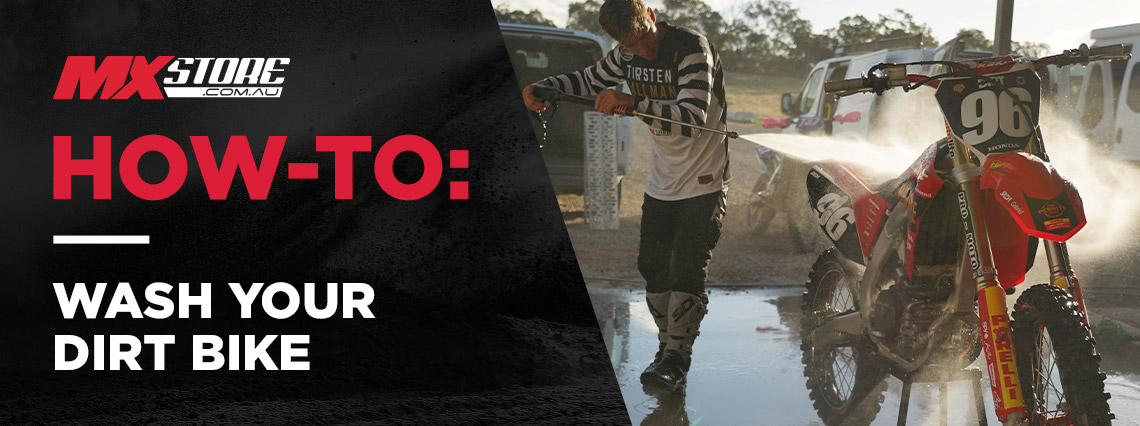How-To: Wash Your Dirt Bike

Cleaning your dirt bike is an essential (but not the most enjoyable!) task to keeping your bike in the best shape possible. Not only will it keep everything running smoothly but will extend the life of moving parts and give you the chance to perform the essential post-ride inspection that will let you identify any damage that may need to be fixed prior to your next ride. Depending on who you talk to, there are a few different ways to attack washing your dirt bike – here at MXstore we have compiled the following list of tips/tricks & steps to getting this tedious task done quickly so you can focus on planning your next ride!
Initial assessment
If your bike is super muddy it is always great to try and get the excess mud off prior to washing the bike. Place your bike on a stand, put in an exhaust bung and try and remove as much mud as possible with the hose. Alternatively, the job can be done easier with more pressure – check out MXstore's range of Pressure washers and other Workshop Tools here.
Once the bulk of heavy mud clumps and dirt has been removed – we can start giving the bike some proper attention. Before doing anything else, we recommend removing any bash plates/skid plates and covering your air filter for protection. This can be done by either placing a plastic bag over the air filter (messy) or by our preferred method of removing the air filter and replacing it with one of our airbox wash covers for maximum protection. This will also allow you to clean out the airbox and remove any excess dirt that has built up from your ride.
Ok, so your bike is ready to wash, you have placed it on a stand so that both wheels are off the ground, removed excess mud, removed your bash plate (if you have one) and covered the air filter to keep it dry.
Its time to degrease!
The next step required is to get a bike wash (sometimes called bike degreaser) and to mix up and spray over the bike. This step is going to do the majority of the wash – so be generous! Make sure it foams up and leave no area untouched. Depending on the wash used – the next step is to let the bike soak for at least 10-15 minutes.
While you are letting the bike soak, quickly mix up some more wash into a bucket and wash some parts like your bash plate and seat if you removed them in preparation. The bike wash mixed up in a bucket of water combined with a sponge and soft brush will be fine – browse our range of wash tools here.
Ok, the bike has soaked and its time to hit it with some water again to remove everything that the cleaner has eaten through. As said before, a pressure washer works best but this can be done with a hose too. Start off by hitting under the front and rear guards, then the wheels and tyres, then focus on the handlebars followed by the bodywork and then the engine last.
By doing this you will find the bike is 90% clean with minimal effort, now just get your bucket, sponge and brush that you prepared earlier. Sponge all of the plastics, the handlebars and controls, then grab the soft brush and focus on the frame and engine. Finish by focusing on the suspension/swingarm chain and sprockets, then finally paying attention to the hubs, spokes and rims. By doing these final steps it will help remove the dirt that the initial soak did not remove.
While up close and personal with your bike this is the perfect opportunity to inspect for any damage that may need to be looked at prior to your next ride... Take note!
The bike is now able to be hit with water for its final rinse – again just with the hose or as mentioned our preferred method of a pressure washer.
Don’t forget to rinse the extras that you removed from the bike. If you are washing your seat – try not to hit the underside too much with water as if increases the change if you get the seat foam all wet.
You are almost done, finally take your bike off the stand, bounce it around and shake it around to try and remove any excess water and then let it sit to dry for a while.
The last and final step is to refit the bash plate, refit or replace the air filter (routine maintenance) and then lubricate the chain using a quality chain lube and lube all moving parts such as footpegs etc with a quality multipurpose spray.
Make a note of anything that needs to be replaced or added to your next pre-ride check and you are good to go.
Happy riding!!